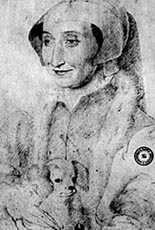

 |
 |
||||||||||||||
|
Marguerite was born in 1492, the sister of the king François Ier. Her mother saw to it that the education afforded to François was available to her daughter as well. Later, at her brother's court, she frequently came into contact with the great minds and poets of her time. When she was 17, she married the duke of Alençon who died in 1525, as a result of wounds he received in a battle during which François was taken prisoner. Her efforts helped to secure his release. She married Henri d'Albert and became queen of Navarre in 1527. She was a religious woman, something of a mystic, who had evangelical leanings: she was among those who, from within the Catholic Church, were pushing for reforms. Her court became a refuge for those poets and thinkers who had Protestant convictions, such as Clément Marot; she read Luther, and corresponded with Calvin. One of her works, the Miroir de l'Ame pécheresse, was soundly condemned by the Sorbonne. Her brother intervened on her behalf, but began to take a distance from her. Marguerite also wrote poetry, including one work entitled Dialogue en forme de Vision nocturne. Marguerite de Navarre died in 1549. The tale recounted here is from Marguerite's most famous work, the Heptameron. Inspired by Boccaccio's Decameron, Marguerite imagines not a group of people fleeing the plague, but rather an assortment of nobles unable (because of bad weather) to leave the spa in the Pyrenees where they have been enjoying the famous baths. They agree to hear ten stories each day for ten days, but actually they reach only about 70, or one week's worth (heptameron means seven days, as decameron means ten days), and the book is thus the collection of these fictions. The first publication of the Heptameron, in 1558, is somewhat chaotic: the framework for the work, borrowed from Boccaccio, is completely lost, and many of the stories are truncated. A better edition appears the following year, but it is only in the 19th century that a thorough edition, based on the author's manuscripts, can be published. For some time, people doubted that Marguerite de Navarre had written the Heptameron, not only because of prevalent expectations about women's writing, but also because Marguerite's religious convictions would have seemed to preclude the inclusion of the more ribald stories. Marguerite creates the characters who recount these stories, and in recent years it has been recognized that she provides a variety of moral and psychological perspectives, none of which is necessarily her own. Below is a portrait of Marguerite de Navarre: 
|